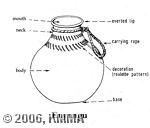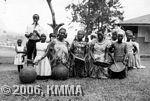




Other name: enaga
The enyungu is not in itself a musical instrument but a utensil that is used as an instrument. It is a large earthenware pot with a short neck and a wide opening with curved edges that is usually used to store beer but can also serve as a percussion instrument. The pot is usually between 30 and 40 cm in height and 35 cm wide. A rope is looped around the neck of the pot so the enyungu can be carried.
To make an enyungu, clay is mixed with potsherds to ensure that the clay does not crack during firing. Once the pot has been thrown, it is left to dry out for several days and is then fired. No further decoration or drawings are applied.
The enyungu is played by men and women, either crouching beside the pot or standing upright holding the pot under their arm. The sound is produced by beating a fan-shaped drumstick made of banana fibres against the opening of the pot. No additional fluids are put into the pot to change the sound. In the past the enyungu used to be played by women, who stretched an animal skin over the pot as a membrane. The enyungu was mainly used as a resonator.
Despite the popularity of the engoma, the enyungu has not disappeared from the musical stage. The enyungu plays the same dance rhythms in unison with the engoma. The enyungu is never played solo but is always combined with drums and/or hand-held and ankle rattles.
The enyungu is played by all the peoples in Ankole and is thought to be have been introduced by the Hima.
for more information see also: VAN THIEL, Paul, "Multi-Tribal Music of Ankole. An ethnomusicological study including a glossary of musical terms." Edited by the Royal Museum for Central Africa, Annales, Sciences Humaines, nr 91, 1977, 234 pp.
© KMMA/Paul VAN THIEL